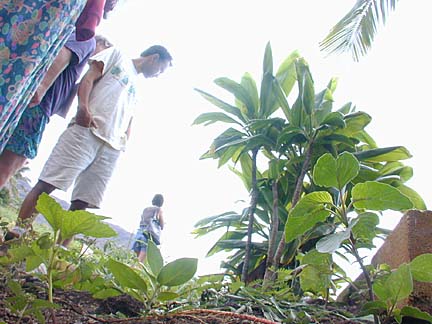Advertisement - Click to support our sponsors.


Dig This![]()
Friday, February 16, 2001

By Craig T. Kojima, Star-Bulletin
Students of medicinal herbs gathered at Hoa Aina O Makaha to
pool their knowledge on the uses of common local plants.
Plants from weeds -- like the oxalis, or ihi, below -- to the
venerable ti, above, contain healing properties.
The next time you go out to weed the garden, watch what you throw away. Common plants can heal
"A lot of the common plants people find around their houses, you know, weeds, have medicinal uses," said Mark Hamamoto, who studies oriental medicine at the Institute of Clinical Acupuncture and Oriental Medicine in Honolulu.
He recently helped organized a five-day course on growing medicinal plants in Hawaii. The lead instructor was Michael Pilarski, director of Friends of the Trees Society, based in Washington state.
There are herbs for almost every medical condition, according to Pilarski. And while many are safer than pharmaceutical treatments, it is always best to consult with an expert, he said
Oxalis, or ihi, is an example of a common weed with medicinal properties. The tiny small clover-looking plant has a yellow flower and can be brewed into a tea for use in treating respiratory trouble and clearing phlegm.
The day Pilarski and his students spent at Hoa 'Aina O Makaha farm provided an opportunity to discuss the properties of the wide range of plants growing there; even the ones that weren't actively being cultivated.

Nut grass, for example, that scourge of local gardeners, apparently has redeeming qualities."It's just like peanuts," said Butch Richards, a semi-retired teacher who was taking the class.
"If you're ever starved. just pull that out, boil it and eat it. It's very healthy, lots of protein."
Aloe vera, with its healing gel, may be one of Hawaii's best known medicinal plants. Awa, or kava, is one that has gotten a lot of recent press. Many believe it has commercial potential.
"(Pilarski's) trying to promote the idea that growing medicinal herbs is a growing business and Hawaii can play a part in it," said Hamamoto.
For the home gardener, the reward may be in using plants already in place.
"Gardenia is very good for clearing liver chi stagnation," said Hamamoto. It is also used to treat eye problems and tight tendons.
All herbs used in a traditional Chinese medicine are dried first then used in combination, he said. "Very rarely are Chinese herbs taken singly," said Hamamoto.
Conversely, in la'au lapa'au -- the application of Hawaiian medicinal herbs -- plants, or parts of plants, are often used raw or juiced.
Watercress juiced with a little lemon added is used to treat emphysema, said Richards. The liquid is easier for the body to digest, he said.
"The faster we can get it to the cellular level, the faster action will take place in the human body," said Richards.
High levels of chlorophyll in ti, or ki, make the leaves effective in treating skin problems, he said.
The gel from naupaka leaves also heals cuts, and soothes rashes and stings, said Pilarski.
For more serious ailments, Hawaiians and other Polynesians have long looked to the noni fruit. It is used for everything from diabetes to high blood pressure, ulcers to cancer, according to Pilarski. The market for noni juice is growing worldwide.
Two other Hawaiian herbs growing in popularity are mamaki and ko'oko'olau, according to Pilarski.
The bark of mamaki, a shrub or small tree, is used in tonics and its fruit is a mild laxative. Its leaves are also used in medicinal teas.
Ko'oko'olau refers to a number of related species of the Bidens genus. The leaves and flower buds of these plants are used in teas to treat blood disorders, as well as throat and stomach ailments, according to Pilarski.
All together, more than 100 plant species are employed by practitioners of la'au lapa'au, according to Pilarski.
Richards was trained by his mother and grandparents in the use of Hawaiian medicinal plants. "I was brought up at a young age doing this," he said.
He took Pilarski's class because he enjoys being in the role of student for a change.
"It's nice to come and hear someone else talk," he said. "To me there's always room to learn."
Richards offers classes in la'au lapa'au. For more information, call 548-0377.
Gardening Calendar in Do It Electric!
Stephanie Kendrick's gardening column runs Fridays in Today.
You can write her at the Star-Bulletin, P.O. Box 3080, Honolulu 96802
or email skendrick@starbulletin.com